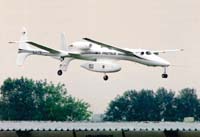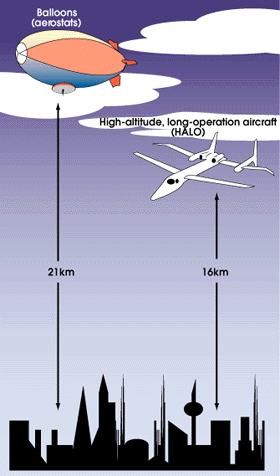Sub-orbital broadband: More than just hot air?
01 September 1999
Broadband links offer an
appetising slice of the Internet access pie, and satellite systems
are one way to provide it. But solutions that lie closer to the
earth are also more than just pie in the sky, as Terry Edwards
reports.
 Suddenly, it seems, everybody wants to be
in the race to transform the 'world wide wait' into a 'world wide
comparatively quick and moderately easy to get at' facility. It's a
given, of course, that high-speed Internet access requires broadband
communications links, and with the global market for Internet
backbones expected to be worth US$20 billion (E18.9 billion) by
2004, there's a great big appetising pie out there just waiting to
be sliced - and the industry can smell it. Thus, among the projects
either on the drawing board or on the way to becoming reality are
broadband satellite systems and broadband terrestrial networks (LMDS
and the like) - and the new 'subspace' flying base station systems
that are high altitude but, by definition, certainly not
orbital. Suddenly, it seems, everybody wants to be
in the race to transform the 'world wide wait' into a 'world wide
comparatively quick and moderately easy to get at' facility. It's a
given, of course, that high-speed Internet access requires broadband
communications links, and with the global market for Internet
backbones expected to be worth US$20 billion (E18.9 billion) by
2004, there's a great big appetising pie out there just waiting to
be sliced - and the industry can smell it. Thus, among the projects
either on the drawing board or on the way to becoming reality are
broadband satellite systems and broadband terrestrial networks (LMDS
and the like) - and the new 'subspace' flying base station systems
that are high altitude but, by definition, certainly not
orbital.
Any examination of the pros and cons of subspace
systems must begin by asking the fundamental question: do we really
need broadband communications systems at all? Posing such a query
may seem heretical in this day and age - especially considering all
the time, money and effort that has gone into their development -
but the outlook for the broadband satellite market is, at best,
clouded; and in parts, and for various companies, both gloomy and
stormy - especially as new, less expensive but extremely competitive
non-satellite options will shortly come on stream.
Provided
that companies can convince the financial markets to back their
schemes, it can make perfect business sense to spend tens of
billions of dollars on infrastructure investments. However, the
proof of the pudding comes with quantifiable and reliable returns on
the investments (ROI) made. Companies have to justify their claim
that they are spending to exploit real opportunity, and this is not
only a matter of the rate of return on investment but also of its
timing - how long after the system is up and running does payback
start?
Some very big and very rich companies and industry
consortia have already leveraged their assets and made financial
agreements to fund massively expensive satellite projects. And, as
Iridium is proving, the market can bring even the biggest and
highest-tech project to its knees. That said, at the terrestrial
level a tried and tested fibre-optic infrastructure is already in
place and seems to be able to handle everything that the demands of
broadband communications can throw at it.
However, fibre is,
by definition, a fixed system and therefore inherently incapable of
coping with the demands of mobile. The same is true of the growing
network of terrestrial broadband millimetre-wave systems, dominated
by local multi-point distribution services (LMDS). They too are best
able to meet fixed rather than mobile requirements.
Given
that state of affairs, for some time now it's been accepted that the
solution to high-speed Internet access and other connection
facilities for mobiles will be through broadband satellite. The
satellite industry and its many partners, many of whom are betting
their bottom line on the success of broadband satellite systems,
have hogged the limelight for years, but there are alternatives that
cost much less and might do an equally good - or, dare one whisper
it, perhaps even a better - job.
The biggest and best-known
broadband satellite projects are probably Astrolink, EuroSkyWay,
SkyBridge and Teledesic. Each of these projects is well advanced,
technologically viable, and properly financed, and all have the
benefit of considerable political support from their nations of
origin. These systems are designed to provide a combination of
metropolitan and rural coverage and, if they work in the way they
are supposed to, should cope well with mobile needs.
| How the high fliers
compare |
| |
 |
However,
if these companies get their marketing, their services and their
tariffs right (as Iridium so conspicuously didn't), the sheer number
of subscribers they could attract might, ironically, affect the
quality of service they can provide. It is expected that the global
market for broadband subscribers will exceed 300 million by the year
2004, and if that estimate is anywhere near the truth, the most
complex communications architectures will be necessary just to keep
the systems up and running.
At first glance, some of the
proposed subspace projects seem, shall we say, eccentric. And, to be
fair, the notion that airships and circling planes might carry
transponders and provide broadband services can, and still does,
cause either raised eyebrows or suppressed guffaws. However, these
projects are genuine and serious; they have been costed out, are
technically feasible and, if deployed, will no doubt work.
Furthermore, worldwide regulatory approval for the use of
stratospheric platforms was granted by the Federal Communications
Commission of the US in July 1997 and by the International
Telecommunications Union in November that same year - so these
things are rather more than castles in the air.
Thus,
although until now the subspace programmes have had a much lower
visibility than the broadband satellite systems, they may well yet
prove themselves to be at least as important - if not more
important.
So what exactly do these subspace flying-base
station systems consist of? Well, operating very much closer to the
surface of the earth than the low-earth orbit satellites (LEOs),
they are made up of either 'aerostats' (which are basically a kind
of balloon) or special aircraft that carry transponder platforms for
broadband communications services.
Dirigible and
balloon-based comms systems have been used quite extensively by the
military for a number of years, but the relevant technology had not
been available in the civilian arena until recently, so balloons
were not considered to be viable alternatives to satellite systems.
Aircraft too, despite their easy availability, were precluded from
serious consideration mainly because of doubts about their
reliability while airborne and the cost of their maintenance while
on the ground.
However, the latest developments in airframe
and engine construction should permit slow-flying aircraft to hold
position in tightly controlled and specially designated aerial zones
for many hours at a stretch. That said, as these things would be
constantly circling big cities, no regulator expecting to be
re-appointed nor any legislator hoping to be re-elected is likely to
sanction the use of unmanned robot vehicles. As for the manned
vehicles, spare a thought for the pilots. While necessarily well
paid they will surely have one of the most boring jobs on (or in
this case, just off) the face of the earth.
The chart above
demonstrates the main comparisons between broadband satellite and
broadband subspace systems. Among the advantages common to all
subspace systems are: comparatively low capital investments
(subspace systems come in at about $100 million (EUR94.6 million)
each), quick deployment, short ROI, and even shorter transmission
delays (similar to terrestrial). On the downside, subspace systems
will never be able to provide the combination of global urban and
rural coverage, or metropolitan concentration via the spot beams,
that satellite systems can. Most of the proposed non-orbiting
subspace projects will look to the cities and big connurbations for
their subscriber base; several organisations have plans to deploy
geostationary subspace stratospheric balloons and dirigibles in the
near future.
Probably the best known of these is Sky Station
International, of Washington DC, which will have its aerostats aloft
and in service early next year.
Not one to undersell itself,
the company has it that, taken together, its vision and technology
make up one of the most significant innovations since the invention
of the communications satellite.
The ultimate plan is that,
by 2005, the Sky Station 'Stratospheric Telecommunication Service',
will comprise a flotilla of 250 helium-filled balloons hovering 21km
above the world's biggest cities. At 21km, the balloons will be at
just over twice the height that today's commercial jet airliners
fly.
If things go to plan, and there seems little reason why
they shouldn't, in just a few years these balloons will be a
familiar sight to airline passengers and will appear as a
constellation of bright new stars to viewers on the
ground.
Elsewhere, the Japanese Ministry of Posts and
Telecommunications has advanced plans for an airship-based broadband
access network; and Italy's Turin Polytechnic is working with the
Italian Space Agency (ISA) to develop and build a long-endurance
aerostat that will be powered by fuel cells for night operation and
solar energy by day. The total investment for the Turin/ISA program
is expected to amount to only about $3 million (EUR2.8 million) and
the operating cost might be as low as $345 (EUR326) per
hour.
At that sort of level, the investment needed is at
least an order of magnitude lower than that required for LMDS or
other broadband terrestrial wireless networks, and about two orders
of magnitude below the investment levels associated with most
broadband satellite projects.
Meanwhile, in Israel, Tel Aviv
University is developing a network called RotoStar. An unmanned
rotating-wing aircraft rather than a balloon or an airship, this
system would actually hover at the same altitude as both Sky Station
and the proposed system from Turin/ISA. However, unlike these
designs it would be capable of remaining on station for between four
days and an astonishing six months.
At present, the main
contender in the high-flying aircraft-based broadband-access stakes
is HALO - which stands for High Altitude Long Operation.
The
HALO system consists of a whole fleet of high-flying aircraft, each
of which carries broadband transponders.
Proteus, the
specialised aircraft designed for Angel Technologies of St Louis,
Missouri in the US by the Wyman-Gordon company, sports a large
underbelly antenna and, flying 16km above the city centres, will be
capable of delivering very high-speed communications services. The
HALO-Proteus aircraft is designed to augment both terrestrial
microwave towers and orbiting satellites, and, it is claimed, will
fly fixed-pattern stratospheric routes to provide metropolitan
wireless services, at much lower cost and with more flexibility and
better quality of service than either current satellite or
fibre-based services. HALO will offer a variety of fixed and mobile
wireless services, including voice, data and video.
And the
HALO system is not just pie in the sky. In August last year Angel
Technologies conducted a flight test using ground and airborne
electronics developed by Massachusetts-based Raytheon Company. The
result was a record-breaking 52Mbit/s wireless link between the
ground and a Proteus testbed aircraft in flight. Under this teaming
agreement, Raytheon has responsibility as the prime electronics
systems integrator for both the airborne and ground segments of the
HALO network. The plan for now is that 100 Proteus aircraft will be
built.
In commercial service, the Proteus aircraft will
circle for periods up to 16 hours at a time at an altitude of 16km.
From this height the aircraft can provide coverage footprints, or
'cones of commerce' as the company prefers to term them, with
diameters of up to 120km. Twenty-four hours a day, seven days a
week, 365 days a year broadband communications availability will be
provided. The aircraft will communicate between HALO gateways,
high-capacity business premises and domestic subscriber premises and
also provide connections to remoter metropolitan
centres.
Angel Technologies says that, for individual
subscribers, a system of this type should, in the very early years
of the new century, readily provide 1.5Mbit/s Internet connection at
a price tag of around $40 (EUR38) per month. In the case of
dedicated commercial customers connect speeds of up to 54Mbit/s are
promised and the total network capacity exceeds
16Gbit/s.
Fittingly it will be Los Angeles, the 'City of
Angels', that will be the first place to have access to an Angel
Technologies network. Thirty further US metropolitan areas are on
the list for service. Thereafter, it is expected that major cities
in many other parts of the world could soon deploy such wireless
networks.
| Harping On About HALO's
Advantages |
| |
Compared with
terrestrial networks, systems such as HALO offer the following
distinct advantages:
rapid network deployment
ubiquitous coverage from day one
line-of-sight communications to 99.99% of city
rooftops
no towers and no local zoning restrictions
network flexibility plus quick and easy
upgrading.
Compared with satellite systems, HALO also
has the following advantages:
it is between 20 and 2,000 times closer to users
it provides much greater and much cheaper availability
electrical power is on board the aircraft
substantial capacity can be allocated directly over
densely populated regions
the network is extremely flexible and can be readily
upgraded
financing is on the basis of one market at a
time.
With high-flying, long-duration manned aircraft
systems the main challenges are likely to be human rather than
technological; the future of such systems probably lies with
unmanned, remotely piloted, automatically navigated,
aircraft.
Also, given the present state of the market,
it is not too far-fetched to speculate that, in the medium to
long term, a substantial proportion of broadband high-speed
Internet access will be facilitated not by satellite systems
alone but by a combination of subspace technologies. Some
systems may even be hybrids of broadband satellite and
subspace.
And in all cases - even if, against all
apparent odds, satellite systems do gain the ascendancy -
integration with existing and planned terrestrial networks
will be vital to the long-term viability and success of HALOs.
This means efficient handovers between broadband platforms and
third-generation mobile terrestrial networks, as well as
backward compatibility with second generation networks, will
be essential. |
|
|












